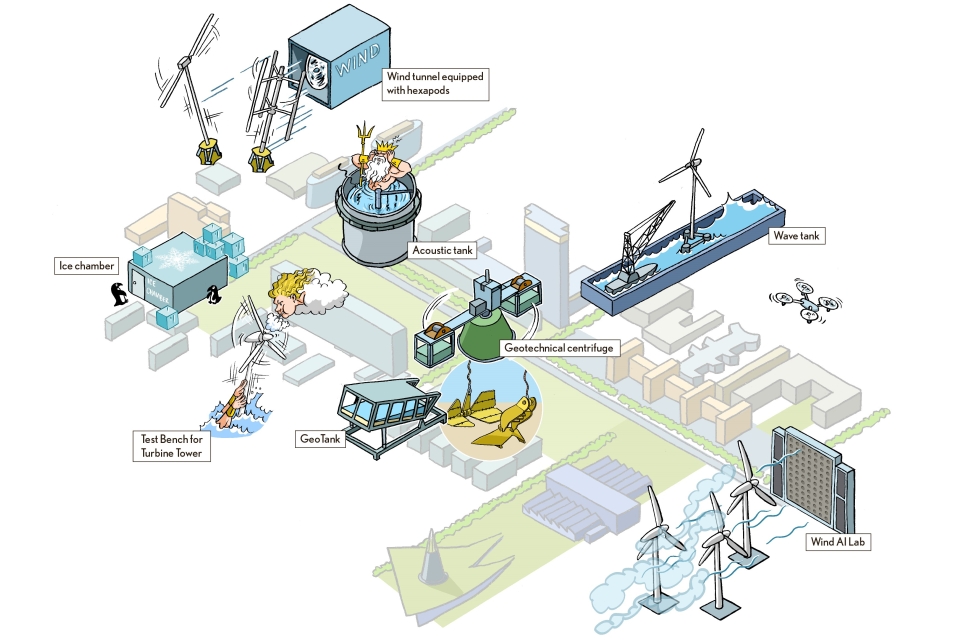The Delft University of Technology (TU Delft) feels floating offshore wind has enormous potential. ‘To capitalise on this potential, TU Delft is launching the Floating Renewables Lab: a lab facility that will tie together all the elements of the development chain for floating wind turbines and other offshore renewables with the help of numerical models and AI,’ says Axelle Viré, wind expert at TU Delft.
If it is up to the European Commission, all the energy used will come from renewable sources by 2050. Achieving this goal will require the large-scale use of floating wind turbines, according to the TU Delft.
Also read: VIDEO: Heerema presents Floating to Floating offshore wind installation method
Using deep oceans
The Dutch are lucky. They live on the shores of a shallow sea, where it is easy to anchor wind turbines to the seabed. However, much of the world’s oceans are too deep for this, explains Viré. ‘Once the sea gets deeper than about fifty metres, you can no longer attach the turbines to the seafloor, or in any case only with additional difficulty, and uneconomically. Instead, you have to erect them on floating platforms that are kept in place with cables and anchors.’
It is a technique that is still in its infancy, but for which there is now a lot of interest. The European Commission has proposed to increase Europe’s offshore wind capacity from the current 12 GW up to 400 GW by 2050, of which one third is expected to be generated by floating wind turbines. This will be complemented with 40 GW of emerging technologies such as ocean energy and floating solar power.
Floating Renewables Lab
As far as Viré is concerned, the brand-new Floating Renewables Lab has a clear role in realising this ambition.
Viré: ‘The Floating Renewables Lab represents almost the entire wind turbine development chain, from A to Z. At TU Delft, for example, they are investigating what the best cables are for attaching to the seabed, and also how to position all those floating wind turbines in relation to each other. Studying these details enables them to substantially increase energy efficiency. Steering the wake – the suction created by the turbine as the water flows past it – is a good example of this. Floating offshore wind turbines offer more degrees of freedom to play with control, such as deliberatively adjusting the angle of the wind turbine in relation to the wind, so that the wake from the turbine is partly or entirely steered around the next turbine, leading to more energy gains.’
What makes the Floating Renewables Lab unique is that it is a combination of eight existing facilities, each with their own features.
‘It is not unique that the Faculty of Mechanical, Maritime and Materials Engineering (3mE) has a towing tank, where research is carried out into how floating wind turbines behave when huge waves form, for example,’ says Viré. ‘Nor is it unique that Civil Engineering and Geosciences (CEG) has a huge hexapod – a six-legged robot measuring 6 by 5 by 3 metres – with which we can improve the construction of the turbine. Nor that the Faculty of Aerospace Engineering (AE) is conducting research into the aerodynamic properties of floating turbines. No, the uniqueness lies in the fact that all these facilities are tied together in a virtual network.’
Viré adds: ‘Some parts of the system are physically tested, while others are simulated using numerical models that can control the hexapod, for example. This requires fast and very accurate models. AI research can work as a catalyst here, allowing us to make these real-time models better and better.’
Also read: IQIP and TU Delft to reduce underwater noise of pile driving
Opportunity for education
There are only a few places in the world where such research into floating wind turbines is being conducted at this scale. But the Floating Renewables Lab is also a unique opportunity for the education programme. ‘We can show students how – by connecting different facilities together – we turn wind into Watts,’ explains Viré. ‘In addition, we hope to connect our lab to the facilities of partner research institutes and companies.’
Picture: TU Delft is launching the Floating Renewables Lab: a lab facility that will tie together all the elements of the development chain for floating wind turbines and other offshore renewables with the help of numerical models and AI (by TU Delft).








